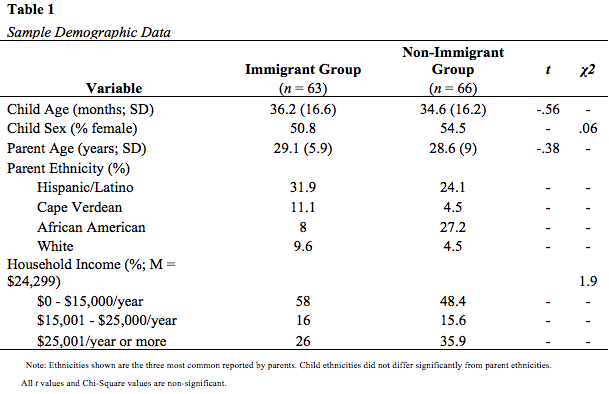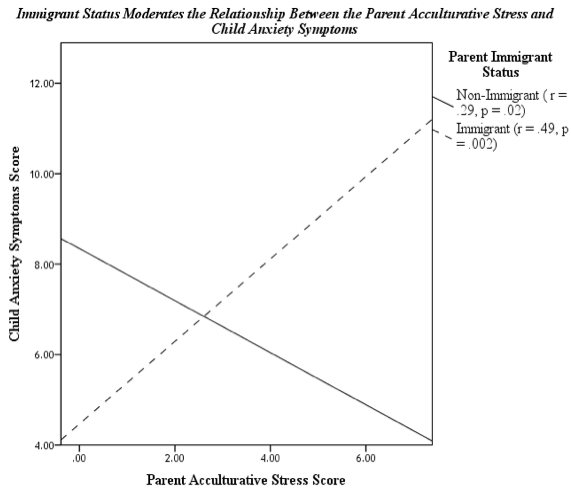Sample demographic information is reported in Table 1. Variations in child anxiety symptoms related to sample demographic characteristics were explored using a series of independent samples t-tests. There was no difference in child anxiety symptoms between boys (M = 6.35, SD = 4) and girls (M = 7.67. SD = 4.07; t = -1.86; n = 134). Also, age did not significantly predict child anxiety symptoms (r = .14, p = .11; n = 135). There was a significant difference in child anxiety symptoms when comparing survey language. Parents who took the survey in Spanish reported higher levels of child anxiety (M = 8.54, SD = 4.54) than parents who took the survey in English (M = 6.72, SD = 3.9; t = -2.02, p = .05; n = 135). However, since Spanish language is highly related to immigrant status, this was not used as a covariate in subsequent analyses. Only one parent who took the survey in Spanish was a non-immigrant (χ2 = .21.3, p < .001; n = 128). The sample mean for the BITSEA (M = 7.05; SD = 4.06) was greater than the norm population mean for the BITSEA (M = 6.7; SD = 3.61).

Preliminary analyses were performed to ensure no violation of the assumptions of normality and linearity. An alpha level of
p < .05 was used as a significance criterion for all statistical tests. Correlations and descriptive data for primary study variables are reported in Table 2. An independent-samples t-test was conducted to compare acculturative stress scores for non-immigrants and immigrants. As expected, immigrants reported higher levels of acculturative stress (
M = 3.05,
SD = 1.98), as compared to non-immigrants (
M = 2.362120) = -2.016ompat,
SD = 1.83;
t = -2.02,
p = 0.046;
n = 122). However, the magnitude of the difference between the means (mean difference = -.695, 95%
CI: -1.378 to -.012) was small (�
2= .008).
It was hypothesized that, for immigrant families, higher scores of stress factors related to acculturation in the parent would predict an increased level of anxiety symptoms in the child. The association between acculturative stress in immigrant parents and symptoms of anxiety in their children (as measured by parent report) was investigated using a Pearson product-moment correlation coefficient. There was a strong positive correlation between the two variables, (r = .42, p = .002; n = 52), with high levels of acculturative stress in the immigrant parent associated with higher levels of anxiety symptoms in the child. When observing the full sample (both immigrants and non-immigrants), acculturative stress in the parent did not significantly predict symptoms of anxiety in the child (r = .06, p = .54; n = 124).
The relationship between acculturative stress and parent emotional functioning was also explored among immigrant parents. A logarithmic transformation was conducted on the BAI summary scale to correct a positive skew of 2.57 to .54. While results were in the expected direction, this finding was non-significant (r = .22, p = .11; n = 52), using a Pearson product-moment correlation coefficient.
In the second hypothesis, it was expected that first-generation and second-generation immigrant children would show an increased level of anxiety symptoms, relative to children whose parents were born in the U.S (non-immigrant children). An independent-samples t-test was conducted to compare level of anxiety symptoms for immigrant and non-immigrant children. There was no significant difference in anxiety symptoms between immigrant children (M = 7.49, SD = 4.6) and non-immigrant children (M = 7.092120) = -2.016ompat, SD = 3.53; t = -.54, p = .59; n = 121), as reported by parents. Levene’s test for equality of variances across groups suggested potential variance (F = 3.76, p = .06), so the t statistic for variant groups is reported. The magnitude of the differences in the means (mean difference = -.402, 95% CI: -1.89 to -1.09) was small (Æ�2 = .002).
The relationship between parent and child anxiety symptoms was also explored. Higher levels of symptoms of anxiety in the parent predicted higher levels of anxiety in the child. As expected, a positive correlation between the two variables was observed (r = .25, p = .005; n = 124), using a Pearson product-moment coefficient.

To determine if immigrant status was a significant moderator for the relationship between parent acculturative stress and child anxiety symptoms, the interaction effect of immigrant status on parent acculturative stress was investigated. An interaction term was created from the product of the mean-centered Immigrant Status and Parent Acculturative Stress variables. Hierarchal multiple regression was used with immigrant status and parent acculturative stress entered in Step 1 and the interaction term (Immigrant Status x Parent Acculturative Stress) in step 2, predicting levels of child anxiety symptoms (BITSEA Anxiety). Immigrant status and parent acculturative stress in Step 1 explained only .8% of the variance in child anxiety symptoms (R squared change = .008, F change (2, 111) = .47, p = .63). In Step 1, the immigrant status variable (b = .01, p = .92) and the acculturative stress variable (b = .09, p = .36) beta weights were both non-significant. After entry of the Immigrant Status x Parent Acculturative Stress interaction term in Step 2, the total variance explained by the model was 13.8%, F (3, 110) = 85.28, p = .001. The interaction term explained an additional 13% of the variance in child anxiety symptoms, after controlling for immigrant status and acculturative stress in the parent, (R squared change = .13, F change (1, 110) = 16.6, p < .001). In the final model, only the interaction term was statistically significant, with the Immigrant Status x Parent Acculturative Stress variable representing a higher beta value (b = .36, p < .001) than immigrant status (b = .03, p = .74) and parent acculturative stress (b = .08, p = .41). Post-hoc analyses indicated that for immigrants, higher levels of parent acculturative stress were related to higher levels of child anxiety (r = .42, p = .002), whereas this relationship was reversed for non-immigrant parents (r = -.294, p = .02).

 Continued on Next Page »
Continued on Next Page »
Alegria, M., Canino, G., Shrout, P., Woo, M., Duan, N., Vila, D., Torres, M., Chen, C., Meng, X. (2008). Prevalence of mental illness in immigrant and non-immigrant U.S. latino groups. American Journal of Psychiatry 165, 359–369. Retrieved from http://ajp.psychiatryonline.org
Barret, P. M., Rapee, R. M., Dadds, M. M., & Ryan, S. M. (1996). Family enhancement of cognitive style in anxious and aggressive children. Journal of Abnormal Child Psychology, 24(2), 187-203.
Bean, F. D., & Tienda, M. (1987). The hispanic population of the united states. (p. 456). New York, NY: Russell Sage Foundation.
Beck, A. T., Epstein, N., Brown, G., & Steer, R. A. (1988). An inventory for measuring clinical anxiety: Psychometric properties. Journal of Consulting and Clinical Psychology, 56(6), 893-897.
Beiser, M., Barwick, C., Berry, J.W., da Costa, G., Fantino, A., Ganesan, S., Lee, C., Milne, W., Naidoo, J., Prince, R., Tousignant, M., & Vela, E. (1988). Mental health issues affecting immigrants and refugees. Ottawa: Health and Welfare Canada.
Berry, J. W. (1997). Immigration, acculturation, and adaptation. Applied Psychology: An International Review, 46(1), 5-68. Retrieved from http://www.unige.ch/international/etudageneve/gisp/prog/Readings/Akkari_Berry.pdf
Berry, J. W. (1998). Intercultural relations in plural societies. Canadian Psychology, 40(1), 12-21.
Berry, J. W. (2006). Acculturative stress. In T. Wong & G. Wong (Eds.), Handbook of multicultural perspectives on stress and coping (pp. 287-295). New York, NY: Springer.
Bittner, A., Egger, H. L., Erkanli, A., Costello, E. J., Foley, D. L., & Angold, A. (2007). What do childhood anxiety disorders predict?. Journal of Child Psychology and Psychiatry, 48(12), 1174-1183.
Breslau, J., Borges, G., Hagar, Y., Tancredi, D., & Gilman, S. (2008). Immigration to the usa and risk for mood and anxiety disorders: Variation by origin and age at immigration. Psychological Medicine, 39, 1117-1127.
Briggs-Gowan, M. J., & Carter, A. S. (2008). Social-emotional screening status in early childhood predicts elementary school outcomes. PEDIATRICS, 121(5), 957-962.
Burnam, M.A., Hough, R.L., Karno, M., Escobar, J.I., Telles, C.A. (1987). Acculturation and lifetime prevalence of psychiatric disorders among Mexican-Americans in Los Angeles.Journal of Health and Social Behavior 28, 89–102. Retrieved from http://www.jstor.org/stable/2137143.
Buss, K. (2011). Which fearful toddlers should we worry about? context, fear, regulation and anxiety risk. Developmental Psychology, 47(3), 804-819.
Caldwell-Harris, C. L., & Ayçiçegi, A. (2006). When personality and culture clash: The psychological distress of allocentrics in an individualist culture and idiocentrics in a collectivist culture . Transcultural Psychiatry, 43(3), 331-361. doi: 10.1177/1363461506066982
Conger, K. J., Reuter, M. A., & Conger, R. D. (2000). The role of economic pressure in the lives of parents and their adolescents: The family stress model. (pp. 201-223). Cambridge, UK: Cambridge University Press.
Collazos, F., Qureshi, A., Antonin, M., & Tomás-Sabádo, J. (2008). Acculturative stress and mental health in the immigrant population. Papeles del Psicólogo, 29(3), 307-315. Retrieved from http://www.cop.es/papeles
Copeland, W. E., Shanahan, L., Costello, E. J., & Angold, A. (2009). Childhood and adolescent psychiatric disorders as predictors of young adult disorders. Arch Gen Psychiatry, 66(7), 764-772.
De Feyter, J. J., & Winsler, A. (2009). The early developmental competencies and school readiness of low-income immigrant children: Influences of generation, race/ethnicity, and national origins. Early Childhood Research Quarterly.
De Las Fuentes, C. (2003). Latinos and mental health. In J. Mio & G. Iwamasa (Eds.), Culturally Diverse Mental Health (pp. 159-172). New York, NY: Brunner-Routledge.
Duru, E., & Poyrazli, S. (2007). Personality dimensions, psychosocial-demographic variables, and english competency in predicting level of acculturative stress among turkish international students. International Journal of Stress Management, 14(1), 99-110. doi: 10.1037/1072-5245.14.1.99
Dumka, L. E., Roosa, M. W., & Jackson, K. M. (1997). Risk, conflict, mothers' parenting, and children's adjustment in low-income, mexican immigrant, and mexican american families. Journal of Marriage and Family, 59(2), 309-323.
Gil, A. G., & Vega, W. A. (1996). Two different worlds: Acculturation stress and adaptation among cuban and nicaraguan families. Journal of Social and Personal Relationships, 13(3), 435-456.
Goldsmith, H. H., & Gottesman, I. I. (1981). Origins of variation in behavioral style: a longitudinal study of temperament in young twins. Child Development, 52(1), 91-103. Retrieved from http://www.jstor.org/stable/1129218
Goldsmith, H. H., Buss, A. H., Plomin, R., Rothbart, M. K., Thomas, A., Chess, S., Hinde, R. A., & McCall, R. B. (1987). Roundtable: what is temperament? four approaches. Child Development, 58(2), 505-529. Retrieved from http://www.jstor.org/stable/1130527
Grant, B.F., Stinson, F.S., Hasin, D.S., Dawson, D.A., Chou, S.P., Anderson, K. (2004). Immigration and lifetime prevalence of DSM-IV psychiatric disorders among Mexican Americans and non-Hispanic whites in the United States: results from the National Epidemiologic Survey on Alcohol and Related Conditions. Archives of General Psychiatry 61, 1226–1233. Retrieved from http://archpsyc.ama-assn.org
Greenberg, P.E., Sisitsky, T., Kessler, R.C., Finkelstein, S.N., Berndt, E.R., Davidson, J.R., Ballenger, J.C., & Fyer, A.J. (1999). The economic burden of anxiety disorders in the 1990s. Journal of Clinical Psychiatry; 60, 427-430.
Hodges, W. F., London, J., & Colwell, J. B. (1990). Stress in parents and late elementary age children in divorced and intact families and child adjustment. Journal of Divorce & Remarriage, 14(1), 63-80.
Kagan, J., & Snidman, N. (1999). Early childhood predictors of adult anxiety disorders. Biol Psychiatry, 46, 1536–1541. Retrieved from http://dionysus.psych.wisc.edu/lit/Articles/KaganJ1999a.pdf
Kagan, J., Snidman, N., Zentner, M., & Peterson, E. (1999): Infant temperament and anxious symptoms in school age children. Dev Psychopathol 11:209–224.
Kagan, J., Snidman, N., Kahn, V., & Towsley, S. (2007). The preservation of two infant temperaments into adolescence. Monographs of the Society for Research in Child Development, 72, 1–75.
Kessler, R. C., Mickelson, K. D., & Williams, D. R.. (1999).The prevalence, distribution, and mental health correlates of perceived discrimination in the united states. Journal of Health and Social Behavior, 40, 3, 208-230.
Kessler, R. C., Berglund, P., Demler, O., Jin, R., Merikangas, K. R., & Walters, E. E. (2005). Lifetime prevalence and age-of-onset distributions dsm-iv disorders in the national comorbidity survey replication. Arch Gen Psychiatry, 62, Retrieved from http://clclinic.cos.ucf.edu/Documents and Files/Kessler, Berglund, 2005.pdf
Kessler, R. C., Ruscio, A. M., Shear, K., & Wittchen, H. (2009). Epidemiology of anxiety disorders. In M. Antony & M. Stein (Eds.), Oxford Handbook of Anxiety and Related Disorders (pp. 19-33). New York, NY: Oxford University Press.
Lara, M., Gamboa, C., Kahramanian, M. I., Morales, L. S., & Hayes Bautista, D. E. (2005). Acculturation and latino health in the united states: A review of the literature and its sociopolitical context. Annual Review of Public Health, 26, 367-397.
Leidy, M. S., Parke, R. D., Cladis, M., Coltrane, S., & Duffy, S. (2009). Positive marital quality, acculturative stress, and child outcomes among mexican americans. Journal of Marriage and Family. 71, 833-847.
Lépine, J. P. (2002). The epidemiology of anxiety disorders: Prevalence and societal costs. J Clin Psychiatry, 63(Suppl. 14), 4-8.
Lueck, K., & Wilson, M. (2011). Acculturative stress in latino immigrants: The impact of social-psychological and migration-related factors. International Journal of Intercultural Relations, 35, 186-195. Retrieved from www.elsevier.com/locate/ijintrel
Mathers, C. D., Theo Vos, E., Stevenson, C. E., & Begg, S. J. (1999). The burden of disease and injury in australia . Bulletin of the World Health Organization, 79(11), 1076-1084.
Moehler, E., Kagan, J., Oelkers-Ax, R., Brunner, R., Poustka, L., Haffner, J., & Resch, F. (2008). Infant predictors of behavioral inhibition. British Journal of Developmental Psychology, 26, 145-150.
Prior, M. (1992): Childhood temperament. J Child Psychol Psychiatry, 33, 249–279.
Rapee, R. M. (2002). The development and modification of temperamental risk for anxiety disorders: prevention of a lifetime of anxiety?. Society of Biological Psychiatry, 52, 947-957.
Rapee, R. M., & Szollos, A. A. (2002). Developmental antecedents of clinical anxiety in childhood. Behaviour Change, 19(3), 146-157. Retrieved from http://www.atypon-link.com
Redfield, R., Linton, R., & Herskovits, M. J. (1936). Memorandum for the study of acculturation. American Anthropologist, 38(1), 149-152. Retrieved from http://www.jstor.org/stable/662563.
Robinson, J. L., Kagan, J., Reznick, J. S., & Corley, R. (1992). The heritability of inhibited and uninhibited behavior: a twin study. Developmental Psychology, 28(6), 1030-1037.
Schwartz, S. J., Zamboanga, B. L., & Hernandes-Jarvis, L. (2007). Ethnic identity and acculturation in hispanic early adolescents: Mediated relationships to academic grades, prosocial behaviors, and externalizing symptoms. Cultural Diversity and Ethnic Minority Psychology, 13(4), 364-373. doi: 10.1037/1099-9809.13.4.364
Suarez-Morales, L., & Lopez, B. (2009). The impact of acculturative stress and daily hassles on pre-adolescent psychological adjustment: Examining anxiety symptoms. J Primary Prevent, 30, 335-349. doi: DOI 10.1007/s10935-009-0175-y
Torres, L. (2010). Predicting levels of latino depression: Acculturation, acculturative stress, and coping. Cultural Diversity and Ethnic Minority Psychology, 16(2), 256-264.
Vega, W.A., Kolody, B., Aguilar-Gaxiola, S., Alderete, E.,Catalano, R., Caraveo-Anduaga, J. (1998). Lifetime prevalence of DSM-III-R psychiatric disorders among urban and rural Mexican Americans in California. Archives of General Psychiatry, 55, 771–778.
Volbrecht, M. M., & Goldsmith, H. H. (2010). Early temperamental and family predictors of shyness and anxiety. Developmental Psychology, 46(5), 1192-1205.
Williams, D. R., Neighbors, H. W., & Jackson, J. S. (2003). Racial/ethnic discrimination and health: Findings from community studies . Am J Public Health, 93(2), 200-208. Retrieved from http://www.ncbi.nlm.nih.gov
1.) While the term “parent” is used throughout this thesis, anyone who identified as a caregiver was eligible to participate.























